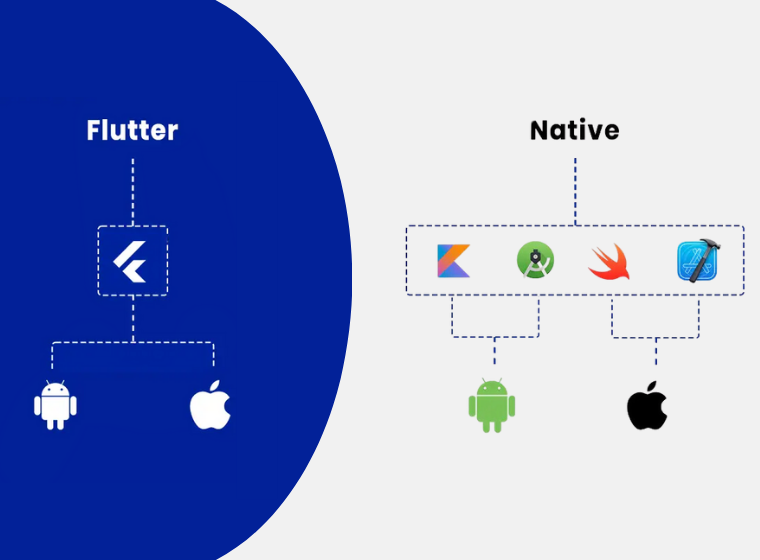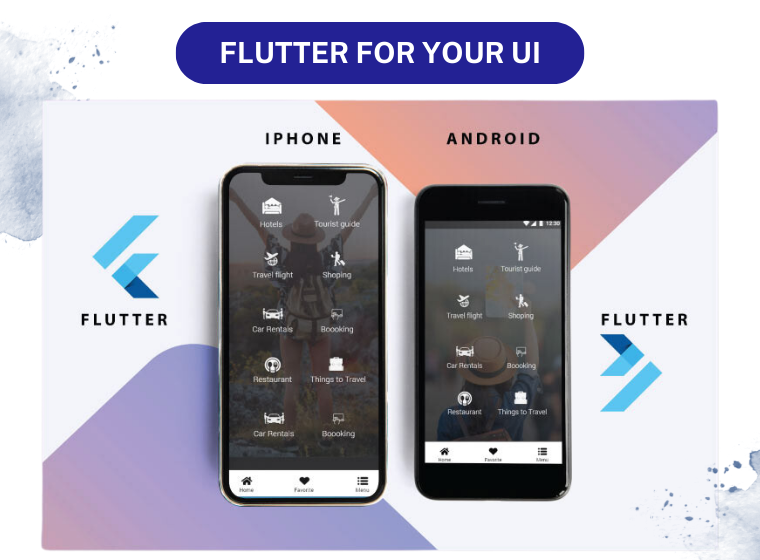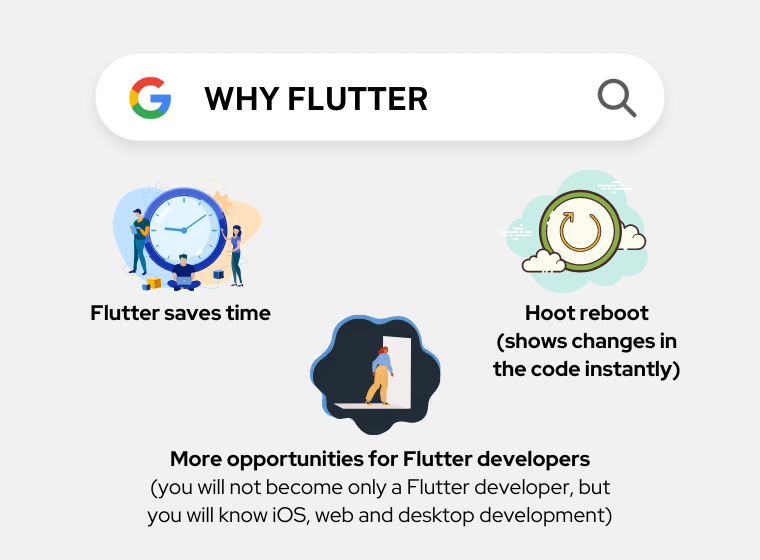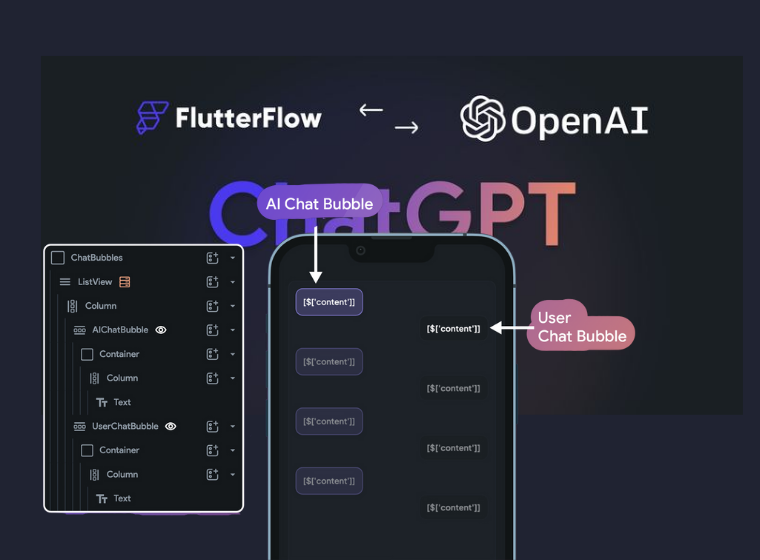Flutter is a cross-platform framework from Google launched in 2017 to develop applications for Android, iOS, Linux, macOS, Windows, Google Fuchsia, and web applications.
Being free, Flutter allows keeping a team small, as it covers different platforms. For example, when a customer hires a Flutter team to develop an Android app, the same team could also develop an iOS and web app using the same laptops. So, Flutter allows you to save up to 200% in development for several platforms.
When we are working with MVP for startups, we use all our tasks using Flutter. Our customers have appreciated the Flutter framework, as it is comfortable for them and allow them to save up. Here we would like to speak about the advantages we enjoy using Flutter, so you could use it for your startup and app development.
Flutter in Brief
- Flutter saves time: you just write code for one platform and if you need more, you can adapt to the platform you need. So you write code for an Android app using Flutter, and if you need an app for iOS, you just add new code lines.
- This framework has a hoot reboot. When you change a letter in program code, a program shows changes instantly. It is not the case when you are coding using native Android and iOS frameworks, as you have to wait until it will be built, so finally, it takes more time to see changes. The same situation is with web development.
- More opportunities for Flutter developers: When you were a strong Android native developer and started to use Flutter, you will not become only a Flutter developer, but you will know iOS, web and desktop development. So with Flutter, you are constantly growing and progressing as a professional.
Do your Startup With Flutter
Flutter allows you to develop your MVP faster and easily, and to add any changes, improvements and fixes in one place. So if you start your startup on your own, Flutter is the best option, as it saves you money, as you could hire only 1 developer for your projects on different platforms (Android, iOS, web)
Using Dart, the developer could create several apps on different platforms using just one code. For example, you could create your MVP on Android to demonstrate it. If an investor supports and finances this project, you could easily launch your product just in one week. Additionally, if there is a need, you could develop your project for iOS using the previous Flutter code for Android.
What language does Flutter have?
Flutter has its own language named Dart, and it has all the features the other languages have.
- Dart is similar to the popular languages - Java and C++. You could easily learn Dart if you used to code on Java for Android and as well as the basic logic is the same as in iOS development.
- Dart allows you to do backend development, so there is no need to learn additional languages.
Flutter Accelerates Testing
When you use Flutter, you need to write the test just one time. Using Flutter, you should just pay once if you are a customer and write just 1 testing code if you are a developer. In native frameworks, testing code should be written for each platform. React Native could be here a good option too, but as we wrote earlier, it has no similar productivity and simplicity.
Additionally, as the coding base is one for Flutter, all bugs could be fixed just in 1 place, so you do not need to look up in different places. With one computer, you could launch 3 emulators for 3 platforms and check how they are working.

Native vs Flutter
Flutter is the best option when developing apps for different platforms, as you need just one computer to cover all the platforms. In Android native development you need to have Windows or Linux laptops, or in iOS native development you should have only MacBook.
Flutter is so comfortable to work with, so even if you have to develop an Android native app, it would be easy to use Flutter and not a native Android framework, as app building with Flutter is faster than with the native Android framework.
Also, Flutter allows fixing an app faster, as it has a range of special instruments (DevTools, Flutter Inspector).
What about the competitors?
You could also use React Native, JavaScript, Xamarin and QT, but their functionalities are weaker than Flutter’s. Let’s analyze them closer.
- React Native is like Flutter a cross-platform network, however, the level of productivity Flutter propose is higher and is at the level of native development. Apps that were developed using React Native are working slowly and have limited capacity. Developers mostly use React Native because a particular project was developed using React Native, and the project should be supported using React Native. Developers prefer to start new projects using Flutter, taking into account the fact that Flutter could work with a piece of a program developed using React Native.
JavaScript is a slow working language, especially in comparison with Dart and other languages. That’s why when an app is built, JavaScript does not use the native elements nor the graphic engine as Flutter does. So such an app is working the same way as a website, which is working slower than a native program.
Scrolling and other elements developed using React Native will be differently displayed on Android platforms, as JavaScript does not work with native elements. So, React Native could be described as something between a native app and a website, and so it is not fast and so the app is acting differently using React Native and on Android.
2. With the cross-platform framework Xamarin from Microsoft, you could write the general logic of a project, but you should write UI separately for each platform, so here you need to learn to code for different platforms. It means that using Xamarin leads to increased costs for the final product, as you need to hire additional developers.
3. The cross-platform (iOS, Android mobile and desktop) Qt framework uses С++ (quite nimble as a language) and has its own graphic elements. However, Qt framework does not support web development and the development of Qt framework has been stopped.
What Flutter proposes for your UI
You could develop any UI you would like: anything you could imagine for your UI could be realized using Flutter (other frameworks do not bring such an opportunity).
In Flutter, everything you see on a screen is built with code. Using code (and not designing) for UI is the new trend launched by Google, and now native development platforms (Android and iOS) are trying to adopt this practice.

However, Jetpack Compose for native development for Android and SwiftUI for iOS do not have the opportunities Flutter proposes. Using Flutter, you write code where showing a picture is asked, and Flutter does it. In Android development, you need to indicate the file with a particular picture and look for options to show it, so Flutter allows you to do it faster.
- Flutter uses widgets, in which you could put one on another and create something new out of it. Native frameworks (Android and iOS) have just one structure. So Flutter provides wider options for creating, including animations that are absent in native frameworks and that could be easily done using Flutter just by writing some pieces of code.
- Another difference is that when we are developing animation using the native Android framework, we need to support this particular version of Android. But with Flutter the situation is different: anything we developed using Flutter will be working using whatever version of Android and iOS, and web platforms. The point is that when we are developing using Flutter, it puts its own graphic engine that works separately and does not depend on the operating system.
- Flutter optimizes app productivity and uses the resources of a device to assist you: when you redesign an app screen, Flutter indicates what part of the code should be changed to be efficient and the developer has not to think about what part should be changed. If you need to redesign text, Flutter redesigns that part of the screen that is responsible for this text.
- When you are working with other platforms, you have to redo all.
- Using Flutter, you cannot be concentrated on the specific design elements for a particular platform - with Flutter, you are developing elements of app design that will be working on iOS and Android platforms. Flutter also eases work for your designer, as the designer has not done different designs for platforms.
Flutter and Its Vast Community
The number of Flutter developers will be growing, as it is easy to start using Flutter for development tasks. So you could boldly hire Flutter developers for your projects, as the workforce proposal is quite wide:
- Google provides code and materials to developers. Every month, Google also issues updates of Flutter’s libraries and Flutter itself, so the platform constantly improves.
- Flutter has its own YouTube channel, where are videos for you to study (no other platform is doing that). For example, this channel posts a video every week about a new library. On the contrary, native frameworks are rarely updated.
- Developers could improve their solutions to any problems and easily share their code with other developers. For Flutter, there are a lot of unofficial libraries. A developer needs just 10 minutes to share a library, and iOS and Android frameworks have only paid options for improvement sharing, and they are not developed at all.
- There are online resources for Flutter, where you could learn Flutter and launch your code.
Flutter and ChatGPT
ChatGPT could write code for Flutter, but you should remember that now ChatGPT writes code as a junior. Junior solves a problem, but the junior’s code could be excessive and not strategically optimized for possible future solutions. Middle and senior specialists anticipate solutions, especially what is about code scalability.
When Flutter does not fit
- There are rare cases when you develop an app that depends heavily on a particular device (for example, an Android) and uses its specific characteristics. But we have no such case in our long practice, and we solve all our tasks using Flutter. Flutter is developing all the time, and so customers have appreciated the advantages it gives, including its cost-efficiency.
- Flutter also could not help you with situations when you are coding an iOS app using a Windows computer, but this problem is caused by the peculiarities of the iOS system.
Bright Perspectives
A new operating system from Google Fuchsia OS that is going to be presented and has ambitions to replace Android OS, was developed using Flutter. So with it, all apps developed using Flutter will work in this new operating system, and in the future, you could write any apps for Fuchsia OS using Flutter.
Takeaways
Flutter allows coming up with an MVP faster and easily add changes if there is a need. It has a wide range of features for creation and development that native frameworks do not have.
Flutter is a promising framework that has a good balance between the sufficient development of the framework, and its growing community. So there are a lot of newcomers who are constantly communicating with their colleagues, so you could easily find specialists for your project. All this makes development with Flutter cost-saving and time-efficient.
Flutter is a cross-platform framework from Google launched in 2017 to develop applications for Android, iOS, Linux, macOS, Windows, Google Fuchsia, and web applications.
Being free, Flutter allows keeping a team small, as it covers different platforms. For example, when a customer hires a Flutter team to develop an Android app, the same team could also develop an iOS and web app using the same laptops. So, Flutter allows you to save up to 200% in development for several platforms.
When we are working with MVP for startups, we use all our tasks using Flutter. Our customers have appreciated the Flutter framework, as it is comfortable for them and allow them to save up. Here we would like to speak about the advantages we enjoy using Flutter, so you could use it for your startup and app development.
Flutter in Brief
- Flutter saves time: you just write code for one platform and if you need more, you can adapt to the platform you need. So you write code for an Android app using Flutter, and if you need an app for iOS, you just add new code lines.
- This framework has a hoot reboot. When you change a letter in program code, a program shows changes instantly. It is not the case when you are coding using native Android and iOS frameworks, as you have to wait until it will be built, so finally, it takes more time to see changes. The same situation is with web development.
- More opportunities for Flutter developers: When you were a strong Android native developer and started to use Flutter, you will not become only a Flutter developer, but you will know iOS, web and desktop development. So with Flutter, you are constantly growing and progressing as a professional.
Do your Startup With Flutter
Flutter allows you to develop your MVP faster and easily, and to add any changes, improvements and fixes in one place. So if you start your startup on your own, Flutter is the best option, as it saves you money, as you could hire only 1 developer for your projects on different platforms (Android, iOS, web)
Using Dart, the developer could create several apps on different platforms using just one code. For example, you could create your MVP on Android to demonstrate it. If an investor supports and finances this project, you could easily launch your product just in one week. Additionally, if there is a need, you could develop your project for iOS using the previous Flutter code for Android.
What language does Flutter have?
Flutter has its own language named Dart, and it has all the features the other languages have.
- Dart is similar to the popular languages - Java and C++. You could easily learn Dart if you used to code on Java for Android and as well as the basic logic is the same as in iOS development.
- Dart allows you to do backend development, so there is no need to learn additional languages.
Flutter Accelerates Testing
When you use Flutter, you need to write the test just one time. Using Flutter, you should just pay once if you are a customer and write just 1 testing code if you are a developer. In native frameworks, testing code should be written for each platform. React Native could be here a good option too, but as we wrote earlier, it has no similar productivity and simplicity.
Additionally, as the coding base is one for Flutter, all bugs could be fixed just in 1 place, so you do not need to look up in different places. With one computer, you could launch 3 emulators for 3 platforms and check how they are working.

Native vs Flutter
Flutter is the best option when developing apps for different platforms, as you need just one computer to cover all the platforms. In Android native development you need to have Windows or Linux laptops, or in iOS native development you should have only MacBook.
Flutter is so comfortable to work with, so even if you have to develop an Android native app, it would be easy to use Flutter and not a native Android framework, as app building with Flutter is faster than with the native Android framework.
Also, Flutter allows fixing an app faster, as it has a range of special instruments (DevTools, Flutter Inspector).
What about the competitors?
You could also use React Native, JavaScript, Xamarin and QT, but their functionalities are weaker than Flutter’s. Let’s analyze them closer.
- React Native is like Flutter a cross-platform network, however, the level of productivity Flutter propose is higher and is at the level of native development. Apps that were developed using React Native are working slowly and have limited capacity. Developers mostly use React Native because a particular project was developed using React Native, and the project should be supported using React Native. Developers prefer to start new projects using Flutter, taking into account the fact that Flutter could work with a piece of a program developed using React Native.
JavaScript is a slow working language, especially in comparison with Dart and other languages. That’s why when an app is built, JavaScript does not use the native elements nor the graphic engine as Flutter does. So such an app is working the same way as a website, which is working slower than a native program.
Scrolling and other elements developed using React Native will be differently displayed on Android platforms, as JavaScript does not work with native elements. So, React Native could be described as something between a native app and a website, and so it is not fast and so the app is acting differently using React Native and on Android.
2. With the cross-platform framework Xamarin from Microsoft, you could write the general logic of a project, but you should write UI separately for each platform, so here you need to learn to code for different platforms. It means that using Xamarin leads to increased costs for the final product, as you need to hire additional developers.
3. The cross-platform (iOS, Android mobile and desktop) Qt framework uses С++ (quite nimble as a language) and has its own graphic elements. However, Qt framework does not support web development and the development of Qt framework has been stopped.
What Flutter proposes for your UI
You could develop any UI you would like: anything you could imagine for your UI could be realized using Flutter (other frameworks do not bring such an opportunity).
In Flutter, everything you see on a screen is built with code. Using code (and not designing) for UI is the new trend launched by Google, and now native development platforms (Android and iOS) are trying to adopt this practice.

However, Jetpack Compose for native development for Android and SwiftUI for iOS do not have the opportunities Flutter proposes. Using Flutter, you write code where showing a picture is asked, and Flutter does it. In Android development, you need to indicate the file with a particular picture and look for options to show it, so Flutter allows you to do it faster.
- Flutter uses widgets, in which you could put one on another and create something new out of it. Native frameworks (Android and iOS) have just one structure. So Flutter provides wider options for creating, including animations that are absent in native frameworks and that could be easily done using Flutter just by writing some pieces of code.
- Another difference is that when we are developing animation using the native Android framework, we need to support this particular version of Android. But with Flutter the situation is different: anything we developed using Flutter will be working using whatever version of Android and iOS, and web platforms. The point is that when we are developing using Flutter, it puts its own graphic engine that works separately and does not depend on the operating system.
- Flutter optimizes app productivity and uses the resources of a device to assist you: when you redesign an app screen, Flutter indicates what part of the code should be changed to be efficient and the developer has not to think about what part should be changed. If you need to redesign text, Flutter redesigns that part of the screen that is responsible for this text.
- When you are working with other platforms, you have to redo all.
- Using Flutter, you cannot be concentrated on the specific design elements for a particular platform - with Flutter, you are developing elements of app design that will be working on iOS and Android platforms. Flutter also eases work for your designer, as the designer has not done different designs for platforms.
Flutter and Its Vast Community
The number of Flutter developers will be growing, as it is easy to start using Flutter for development tasks. So you could boldly hire Flutter developers for your projects, as the workforce proposal is quite wide:
- Google provides code and materials to developers. Every month, Google also issues updates of Flutter’s libraries and Flutter itself, so the platform constantly improves.
- Flutter has its own YouTube channel, where are videos for you to study (no other platform is doing that). For example, this channel posts a video every week about a new library. On the contrary, native frameworks are rarely updated.
- Developers could improve their solutions to any problems and easily share their code with other developers. For Flutter, there are a lot of unofficial libraries. A developer needs just 10 minutes to share a library, and iOS and Android frameworks have only paid options for improvement sharing, and they are not developed at all.
- There are online resources for Flutter, where you could learn Flutter and launch your code.
Flutter and ChatGPT
ChatGPT could write code for Flutter, but you should remember that now ChatGPT writes code as a junior. Junior solves a problem, but the junior’s code could be excessive and not strategically optimized for possible future solutions. Middle and senior specialists anticipate solutions, especially what is about code scalability.
When Flutter does not fit
- There are rare cases when you develop an app that depends heavily on a particular device (for example, an Android) and uses its specific characteristics. But we have no such case in our long practice, and we solve all our tasks using Flutter. Flutter is developing all the time, and so customers have appreciated the advantages it gives, including its cost-efficiency.
- Flutter also could not help you with situations when you are coding an iOS app using a Windows computer, but this problem is caused by the peculiarities of the iOS system.
Bright Perspectives
A new operating system from Google Fuchsia OS that is going to be presented and has ambitions to replace Android OS, was developed using Flutter. So with it, all apps developed using Flutter will work in this new operating system, and in the future, you could write any apps for Fuchsia OS using Flutter.
Takeaways
Flutter allows coming up with an MVP faster and easily add changes if there is a need. It has a wide range of features for creation and development that native frameworks do not have.
Flutter is a promising framework that has a good balance between the sufficient development of the framework, and its growing community. So there are a lot of newcomers who are constantly communicating with their colleagues, so you could easily find specialists for your project. All this makes development with Flutter cost-saving and time-efficient.









